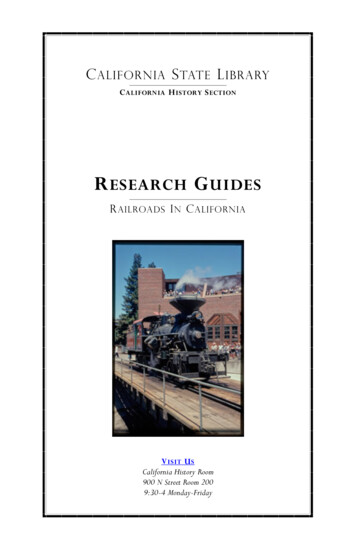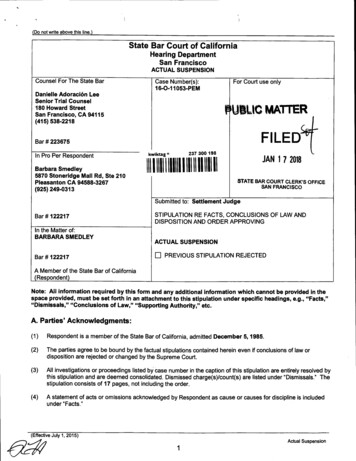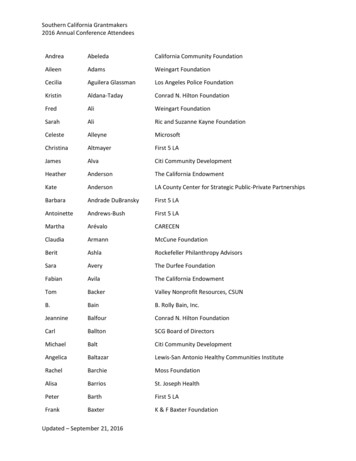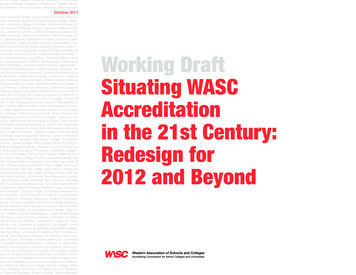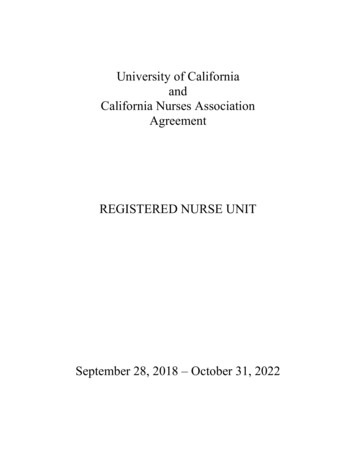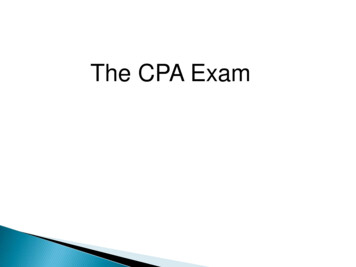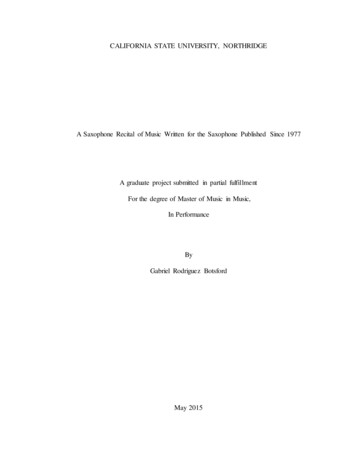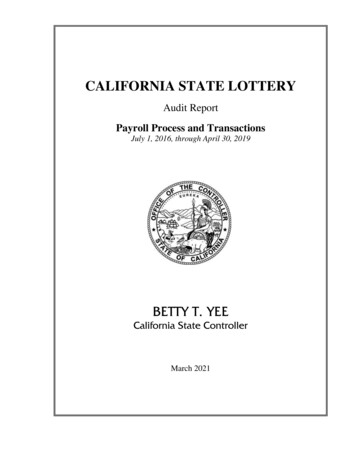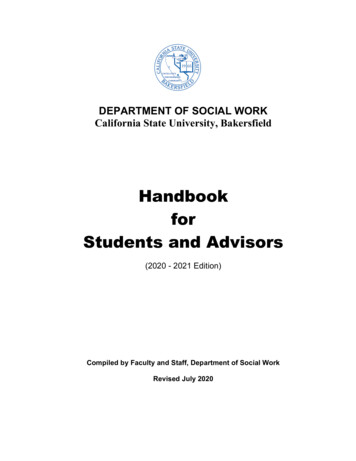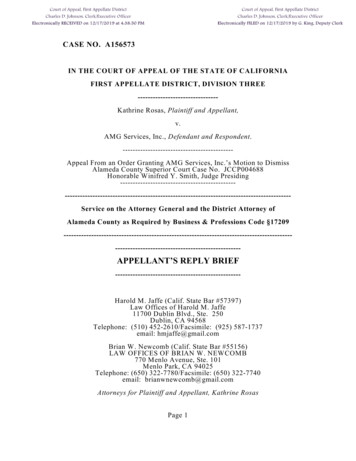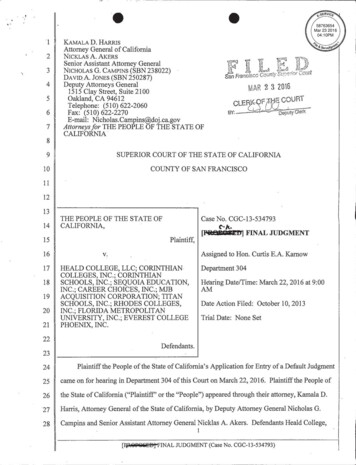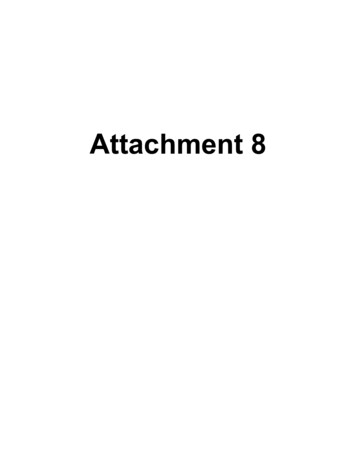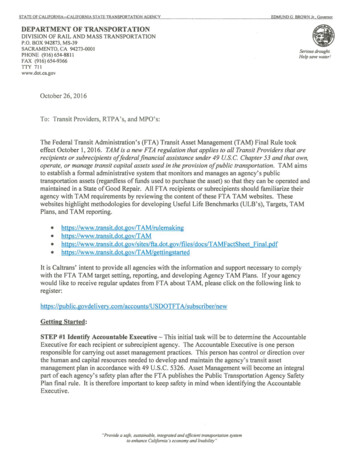
Transcription
STATE OF CALIFORNIA-CALIFORNIA STATE TRANSPORTATION AGENCYEDMUND 0 - BROWN )r DEPARTMENT OF TRANSPORTATIONDIVISION OF RAIL AND MASS TRANSPORTATIONP.O. BOX 942873, MS-39SACRAMENTO, CA 94273-0001PHONE (916) 654-8811FAX (916)654-9366ITY 711www.dot.cagov Serious drought.Help save water.IOctober 26, 2016To: Transit Providers, RTPA's, and MPO's:The Federal Transit Administration's (FTA) Transit Asset Management (TAM) Final Rule tookeffect October 1, 2016. TAM is a new FTA regulation that applies to all Transit Providers that arerecipients or subrecipients offederal financial assistance under 49 US.C. Chapter 53 and that own,operate, or manage transit capital assets used in the provision ofpublic transportation. TAM aimsto establish a formal administrative system that monitors and manages an agency's publictransportation assets (regardless of funds used to purchase the asset) so that they can be operated andmaintained in a State of Good Repair. All FTA recipients or subrecipients should familiarize theiragency with TAM requirements by reviewing the content of these FTA TAM websites. Thesewebsites highlight methodologies for developing Useful Life Benchmarks (ULB's), Targets, TAMPlans, and TAM reporting. Governorhttps://www .dot. ov/files/docs/TAMFactSheet Final.pd[https ://www .transit.dot.govIT AMIgettingstartedIt is Caltrans' intent to provide all agencies with the information and support necessary to complywith the FTA TAM target setting, reporting, and developing Agency TAM Plans. If your agencywould like to receive regular updates from FTA about TAM, please click on the following link toregister:https://public.govdel ive ry .com/accounts/USDOTFTA/subscriber/newGetting Started:STEP #1 Identify Accountable Executive This initial task will be to determine the AccountableExecutive for each recipient or subrecipient agency. The Accountable Executive is one personresponsible for carrying out asset management practices. This person has control or direction overthe human and capital resources needed to develop and maintain the agency' s transit assetmanagement plan in accordance with 49 U.S.C. 5326. Asset Management will become an integralpart of each agency's safety plan after the FTA publishes the Public Transportation Agency SafetyPlan final rule. It is therefore important to keep safety in mind when identifying the AccountableExecutive."Provide a safe, sustainable, integrated and efficient transportation systemto enhance California's economy and livability"
Transit Providers, RTPA's, and MPO-sOctober 26, 2016Page 2To engage TAM, the Accountable Executive will need to decide whether their agency is a Tier I orTier II provider so that the elements required for target setting and the development of TAM Planscan be determined for their agency. Criteria for each of these "tiers" are:Tier IOperates railOR2'.: 101 vehicles across all fixed route modesOR2'.: 100 vehicles in one non-fixed route modeTier IISubrecipient of 5311 fundsOR:5 100 vehicles across all fixed route modesOR:5 100 vehicles in one non-fixed route modeIn California it is assumed that Tier 1 providers will be 5307 recipients, and Tier II providers will beCaltrans 5311 subrecipients. However, there are some 5307 providers that fit the FTA's Tier IIcriteria and/or receive both 5307 and 5311 funding. In either case, FTA and the Division of Rail andMass Transportation (DRMT) are encouraging these providers to work directly with the FTAregional office. It is also important to note that both Tier I and Tier II providers that are recipients orsubrecipients of the FTA Section 5310 funds are also required to include assets purchased with 5310resources if the assets are used in the provision of public transportation services.STEP #2 Setting Targets Targets for TAM must be set so that each agency has an asset baselinefrom which to develop their TAM Plan. The FTA originally stated that targets needed to be set byJanuary 1, 2017 and then annually thereafter. However, the Final TAM Rule did not specify wheninitial targets needed to be reported in the National Transit Database (NTD). For this reason, theFTA and the DRMT will not be collecting targets this year, but are requesting that agencies proceedwith setting their targets so that proper baseline data can be reported in the NTD by the FTA'sJanuary 1, 2018 deadline. So, in essence, the FTA and the DRMT are asking transit providers to dotheir homework but won't be collecting this homework for an additional year. More informationabout establishing targets can be found by reviewing this website:https://cms.fta.dot. gov/T AM/resources/targetsperformanceSTEP #3 Developing TAM Plans These Plans will require local effort championed by a transitprovider or local effort coordinated between transit providers and their TAM Plan Sponsor, which isa State, a designated recipient, a direct recipient or subrecipient that develops a group TAM Plan forat least one Tier II provider. TAM Plans must be in place by October 1, 2018. Tier I providers must develop and carry out their own TAM plan and report directly to theFTA.Tier II providers may develop their own TAM Plan or participate in a single Group TAMPlan that is sponsored, developed, and managed locally. Under this scenario, two or moretransit providers would choose a TAM Plan sponsor and then work collaboratively to developlocally/regionally based ULB's for each asset class. This approach will help ensure targetsremain relevant to local asset replacement needs. Regional Transportation Planning"Provide a safe, sustainable, integrated and efficient transportationsystem to enhance California 's economy and livability"
Transit Providers, RTPA's, and MPO'sOctober 26, 2016Page 3 Agencies (RTPA's) and Metropolitan Planning Organizations (MPO's) could help facilitatediscussions about this point among the transit providers in their region, and are encouraged todo so.Or, Tier II providers can utilize a Group TAM Plan that Caltrans DRMT will sponsor. Underthis scenario, transit providers will utilize standard ULB's that are set by the DRMT and aTAM Plan Template that FTA has developed. This 'standardized' approach could promotetargets for an asset replacement schedule that may not be completely relevant to local assetreplacement needs.All agencies that are recipients or subrecipients of federal financial assistance and utilizethird-party contractors to operate transit service will need to identify the assets utilized bytheir contractors for local services. This information must be contained in the agencies TAMPlan, Group TAM Plan, or in the Group TAM Plan that Caltrans will be sponsoring.Required TAM Plan Elements for each tier are:Tier I & II Inventory of Capital Assets Condition Assessment Decision Support Tools Investment PrioritizationTier I Only TAM and SOR Policy Implementation Strategy List of Key Annual Activities Identification of Resources Evaluation PlanAll 5311 subrecipients are being asked to complete this Survey Monkey by November 30, 2016.https://www.surveymonkey.com/r/5RK88LLData collected from this Survey will help the DRMT determine how Tier II transit providers plan toproceed, and what questions still need to be answered.Coordination with RTPA's and MPO'sThe steps identified above for TAM are each transit provider's responsibility - identifying anAccountable Executive, setting ULB's and targets, reporting, and the development of TAM Plans.However, TAM Plans will ultimately be a planning tool that the FTA, Caltrans, the RTPA's, and theMPO's use to help guide transit program funding decisions in the future. The TAM Plans will needto be updated every four years and should coincide with the Statewide, Metropolitan andNonmetropolitan Transportation Planning, and Programming process so that transportationstakeholders can better define the State Transportation Improvement Program/Federal TransportationImprovement Program priorities and assess investment decisions. For these reasons, transitproviders, RTPA' s, and MPO's should consider the idea of regionally focused TAM Plans and beginTAM coordination activities over the next two regional planning cycles. Work Elements establishedin Overall Work Programs for this coordination are eligible planning activities."Provide a safe, sustainable, integrated and efficient transportationsystem to enhance California's economy and livability"
Transit Providers RTPA's, and MPO'sOctober 26, 2016Page4Training and Technical AssistanceThe Caltrans Federal Transit Grants Office is currently participating in a national dialogue with otherstates to define best practices. Information from this dialogue will be shared with TAM stakeholdersat a later date. This Office is also working with the California Association for CoordinationTransportation (Ca!ACT) to develop training and technical assistance for TAM in rural areas. Weanticipate: A webinar in the fall of 2016 to discuss TAM in more detail with our partners.Having a TAM session at the Spring CaIACT Conference & EXPO April 24-27, 2017.Presenting information about FTA's TAM system and how it can be administered at the nextRural Counties Task Force meeting on November 18, 2016.In the meantime, the DRMT is asking transit agencies to begin TAM discussions so that ULB's forsetting TAM targets can be completed soon in California.If you have any questions about this letter or FTA's new Transit Asset Management Program, pleasecontact me at (916) 654-8655 or Brian Travis at (916) 654-9842.MARK.CODEYOffice ChiefOffice of Federal Transit GrantsAttachment: FTA Transit Asset Management Final Rule Fact Sheet.c:Raymond Sukys, Federal Transit Administration Region IXJosh Shaw, California Transit AssociationJacklyn Montgomery, California Association for Coordination TransportationGiles Giovinazzi, Caltrans Federal LiaisonBruce Roberts, Caltrans, Division of Rail and Mass TransportationJacqueline Kahrs, Caltrans Office of Regional and Interagency PlanningJames Ogbonna, Caltrans Division of Rail and Mass TransportationBruce Plowman, Cal trans Division of Rail and Mass TransportationTracy Harrison, Caltrans Division of Rail and Mass Transportation"Provide a safe, sustainable, integrated and efficient transportationsystem to enhance California's economy and livability"
Transit Asset ManagementState of Good RepairFinal Rule Fact SheetThe Moving Ahead for Progress in the 21 st Century Act(MAP-21) required the Secretary to develop rules toestablish a system to monitor and manage publictransportation assets to improve safety and increasereliability and performance, and to establish performancemeasures, and the Fixing America's Surface Transportation(FAST) Act reaffirmed this requirement. On July 26, 2016,FTA published the Transit Asset Management (TAM) FinalRule. You may view the Final Rule at:https://federalregister.gov/a/2016-16883The condition in which a capital asset is able to operateat a full level of performance. A capital asset is in a stateof good repair when that asset:I. Is able to perform its designed function,2. Does not pose a known unacceptable safety risk,and3. Its lifecycle investments must have been metor recovered.TAM PlansTier I vs. Tier II ApplicabilityThe Final Rule groups providers into two categories: Tier Iand Tier II.Tier ITier IIOperates railSubrecipient of 531 I funds2: IO I vehicles across allAmerican Indian TribeORORORfixed route modesOR2: I00 vehicles in one non-fixed route modeSI00 vehicles across all fixedroute modesORS I00 vehicles in one non-fixedroute modeState of Good RepairThe purpose of the Final Rule is to help achieve andmaintain a state of good repair (SGR) for the nation'spublic transportation assets. Transit asset management is abusiness model that uses transit asset condition to guidethe optimal prioritization of funding. Currently, there is anestimated 85.9 billion transit SGR backlog.The regulations apply to all Transit Providers that arerecipients or subrecipients of Federal financial assistanceunder 49 U.S.C. Chapter 53 and own, operate, or managetransit capital assets used in the provision of publictransportation.TAM Plan ElementsThe following graphic shows the TAM Plan elements that arerequired by each category of provider. Since Tier II providersgenerally operate less complex systems, their TAM Planrequirements are not as extensive.'I.2.3.4.5.6.7.8.9.Inventory of Capital AssetsCondition AssessmentDecision Support ToolsInvestment Prioritizationl'AM and SGR PolicyImplementation SttategyList of Key Annual ActivitiesIdentificatio n of Resourc;esEvaluation PlanTier I & II- ------Jlier I Only
Assets Included in PlanIt is expected that all assets used in the provision of publicTarget Settingtransit will be included in the TAM Plan asset inventory.This includes (with the exception of equipment) assets thatare owned by a third party or shared resources. Theinventory must include all service vehicles, and any otherowned equipment assets over 50,000 in acquisition value.Agencies only need to include condition assessment forassets for which they have direct capital responsibility.Plan ResponsibilityTier I providers must develop and carry out their own TAMplans. Tier II providers may develop their own plans orparticipate in a Group Plan, which is compiled by a GroupPlan Sponsor (generally the State DOT or designated §5310recipient). Tier II §5307 sub-recipients are not required tobe offered a Group Plan, but may participate in one if aSponsor invites them. Each Transit Provider must designatean Accountable Executive to ensure that the necessaryresources are available to carry out the TAM plan and theTransit Agency Safety Plan, regardless of whether itdevelops its own TAM Plan or participates in a Group Plan.Performance ManagementAsset performance is measured by asset class, which meansa subgroup of capital assets within an asset category. Thefollowing table shows the distinction between what assetsmust be included in asset inventories and the assets forwhich transit providers must measure performance.Assets:Only those for which agency hasdirect capital responsibilityEquipmentTargets should be set by each transit provider or TAM plansponsor for each applicable asset class for the coming year.Initial targets must be set by January I, 2017 and then everyfiscal year thereafter. It is recognized that Transit Providersmay not have complete data while setting initial targets. Tothe extent feasible, targets should be supported by data suchas the most recent condition data and reasonable financialprojections for the future, but the overall end goal is to be ina system-wide SGR.Ti meframes/Reporti ngTAM PlansA TAM plan must be updated in its entirety at least every 4years, and it must cover a horizon period of at least 4 years.An initial TAM plan must be completed no later than 2 yearsafter the Final Rule effective date.NTDEach entity developing a TAM Plan will have to reportannually to FTA's National Transit Database (NTD). Thissubmission should include: (I) projected targets for the nextfiscal year; (2) condition assessments and performanceresults; and (3) a narrative report on changes in transitsystem conditions and the progress toward achievingprevious performance targets.PerformanceMeasurePercentage of vehiclesmet or exceeded UsefulLife BenchmarkRolling StockPercentage of vehiclesmet or exceeded UsefulRevenue vehicles by modeLife BenchmarkPercentage of trackInfrastructureOnly rail fixed-guideway, track, segments w/ performancerestrictions by classsignals and systemsPercentage of assetsFacilitiesMaintenance and administrative with condition ratingfacilities; and passenger stations below 3.0 on FTA TERM(buildings) and parking facilities ScaleNon-revenue support-serviceand maintenance vehicles U eful Life Be-nchmarkThe expeeted lifecycle of a capital asset for a particularTransit Provider's operating environment, or theacceptable period of use in service for a particularTransit Provider's operating environment·'Additional InformationMshadoni Smith (Mshadoni.Smith@dot.gov)Final Rule Docket Number: FTA-2016-16883htt ps://www.transit.dot.gov/TAMAugust 2016
The Federal Transit Administration's (FTA) Transit Asset Management (TAM) Final Rule took effect October 1, 2016. TAM is a new FTA regulation that applies to all Transit Providers that are recipients or subrecipients of federal fin
